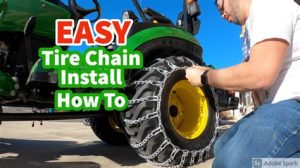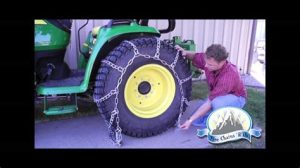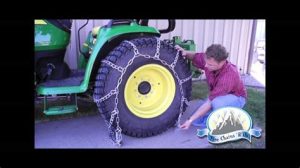Discover how to choose, install, and maintain tractor chains for optimal performance. Learn the benefits and purpose of chains in enhancing your tractor’s efficiency.When it comes to maximizing the performance of your tractor, one often overlooked aspect is the use of tire chains. Whether you’re tackling icy roads or muddy fields, chains can provide the extra grip and stability you need to ensure safety and efficiency during challenging conditions. In this guide, we will explore the purpose of chains, how to select the right ones for your tractor, and the proper installation techniques to get you started. We will also delve into the numerous benefits that come with using chains on your tractor tires, as well as essential maintenance tips to keep them in top condition. Equip yourself with the knowledge to harness the full potential of tire chains, and you’ll be ready to navigate any terrain with confidence. Let’s dig in!
Understanding the Purpose of Chains
Chains play a crucial role in enhancing the performance of tractor tires, particularly in challenging conditions. They provide a significant boost in traction, allowing tractors to navigate through muddy, snowy, or uneven terrains with ease. By wrapping chains around tires, farmers and heavy equipment operators can reduce tire slippage and improve overall grip on various surfaces.
Moreover, the use of chains can help in protecting the tires from excessive wear and tear. When used during harsh weather or challenging job sites, chains absorb much of the strain and stress that tires would typically encounter. This not only extends the lifespan of the tires but also ensures that the tractor operates more efficiently.
Additionally, chains contribute to better safety while operating tractors. In adverse weather conditions where visibility and traction are compromised, the added grip from chains can make a significant difference in preventing accidents and maintaining control over the vehicle. Therefore, understanding the purpose of chains is not just about improving performance; it’s also about safety and longevity of the equipment.
Selecting the Right Chains for Your Tractor
Choosing the right chains for your tractor is essential to ensure optimal performance and safety, especially in challenging conditions.
- Chain Type: There are various types of chains available, including ladder chains, link chains, and diamond chains. Each type offers different levels of traction, and understanding the specific needs of your terrain will help in making the right choice.
- Material: Chains can be made from different materials, such as steel or polymer. Steel chains are generally more durable and provide better performance on icy or muddy surfaces, while polymer chains may be less damaging to the ground.
- Size and Fit: Ensure that the chains fit properly on your tractor tires. The size of the chains should match the tire size to avoid slippage or tearing. Always check your tractor’s manual for the recommended chain size.
Additionally, pay attention to the link spacing and flexibility of the chains. Wider links offer better stability, while more flexible chains can conform better to the tire’s shape for improved traction.
Lastly, consider any local regulations or recommendations when using chains. Some regions have specific guidelines for chain types during winter operations or specific terrain usage.
Proper Installation Techniques for Chains
Installing chains on your tractor tires is crucial for enhancing traction and ensuring optimal performance. Whether you are preparing for winter conditions or muddy terrain, proper installation techniques will help you maximize the benefits of your chains.
- Choose the Right Chains: Confirm that the chains are specifically designed for your tire size and type. This ensures a snug fit and optimal performance.
- Preparation: Before installation, ensure that your tires are properly inflated. A well-inflated tire helps the chains fit snugly and operate effectively.
- Safety First: Always wear gloves and safety glasses to protect yourself during the installation process.
- Positioning: Start by laying the chains out on the ground and make sure they’re free of tangles. Position the chain loops so they face the inside of the tire when installing.
- Installation Process:
- Roll the tractor forward just enough to allow the chain to be positioned behind the tire.
- Lift the chain over the tire, ensuring that it is evenly spaced around the circumference.
- Connect the chains using the appropriate links or fasteners, ensuring they’re as tight as possible without risking damage to the tire.
- Final Adjustments: After installation, drive the tractor for a short distance and then stop to check the chains. Make sure they are properly adjusted and tight, then make necessary adjustments.
It is important to remember that improper installation can result in reduced traction or even damage to your tires, so take your time and follow these steps carefully.
In conclusion, following these installation techniques will help you maintain the integrity of your tractor tires while benefiting from the enhanced traction that chains provide.
Whether you’re dealing with snow, mud, or uneven terrain, applying these methods will ensure you make the most out of chains on your tractor tires.
Benefits of Using Chains on Tractor Tires
Using chains on tractor tires can significantly enhance the performance and safety of your agricultural machinery. These durable accessories act as a powerhouse for traction, especially in challenging conditions such as muddy fields and icy terrains.
- Improved Traction: Chains provide additional grip on slippery surfaces, reducing the risk of slippage and enhancing mobility.
- Enhanced Stability: By improving the contact between the tires and the ground, chains help maintain stability during heavy loads or uneven terrain.
- Increased Longevity: Using chains can protect tires from excessive wear and tear, thereby prolonging their lifespan and saving on replacement costs.
- Versatility: Chains can be used across various types of terrain, making them suitable for seasonal work in diverse weather conditions.
Additionally, the use of chains on tires can also result in better productivity. When tractors operate efficiently, tasks such as plowing, planting, and harvesting can be completed more quickly and with fewer interruptions, which is essential for maintaining a productive schedule.
Moreover, safety is often a top priority for farmers and operators. With better traction and stability, the risk of accidents or machinery getting stuck reduces significantly. This added safety measure can be invaluable in preventing costly downtime and potentially hazardous situations.
In summary, incorporating chains on your tractor tires not only boosts performance in varied terrains but also contributes to the overall effectiveness and safety of your agricultural operations. Taking advantage of this simple yet effective tool can lead to improved outcomes in farming tasks.
Maintenance and Care for Chains
Proper maintenance and care of chains on your tractor tires are essential for ensuring optimal performance and longevity. Regular inspections and proper cleaning can prevent wear and tear, reducing the need for replacements and enhancing efficiency.
To maintain your chains, start by routinely checking for any signs of damage or wear, such as broken links or excessive rust. It’s advisable to keep a maintenance log where you can track these inspections.
- Clean After Use: Rinse off mud and debris immediately after use to prevent corrosion.
- Lubricate Regularly: Use appropriate chain lube to keep the chains flexible and working smoothly.
- Check Tension: Ensure proper tension in the chains, as loose chains can lead to excessive wear or loss.
- Store Properly: Store the chains in a dry area, ideally on a rack, to avoid moisture build-up.
Additionally, it’s important to replace your chains if you notice any severe damage or if they have significantly stretched. A well-maintained set of chains can drastically enhance traction and improve overall farming efficiency.
By following these simple maintenance techniques, you can enjoy a durable and efficient performance from your chains on tractor tires, contributing to better productivity in your farming operations.
Frequently Asked Questions
Why should I use chains on tractor tires?
Chains on tractor tires provide added traction, especially in slippery or icy conditions, improving safety and performance during agricultural operations.
What types of chains are available for tractor tires?
There are different types of chains including ladder chains, diamond chains, and cross chains, each offering various levels of grip and durability for specific conditions.
How do I properly install chains on tractor tires?
To install chains, first park the tractor on a flat surface, then lay the chains out and position them over the tires, ensuring they are evenly distributed and tightly secured.
Are there specific maintenance tips for chains on tractor tires?
Yes, it’s essential to regularly check for wear, ensure they are free from rust, and keep them clean from mud and dirt to prolong their lifespan.
Can using chains damage my tractor tires?
If installed and maintained correctly, chains should not damage tires; however, improper installation or using the wrong size can lead to wear and potential rubbing.
What conditions are best for using chains on tractor tires?
Chains are most beneficial in snowy, icy, or muddy conditions where extra traction is needed to prevent slippage.
Is it safe to drive on paved roads with chains on tractor tires?
Driving on paved roads with chains can cause damage to both the roads and the chains and is typically not recommended unless absolutely necessary.





